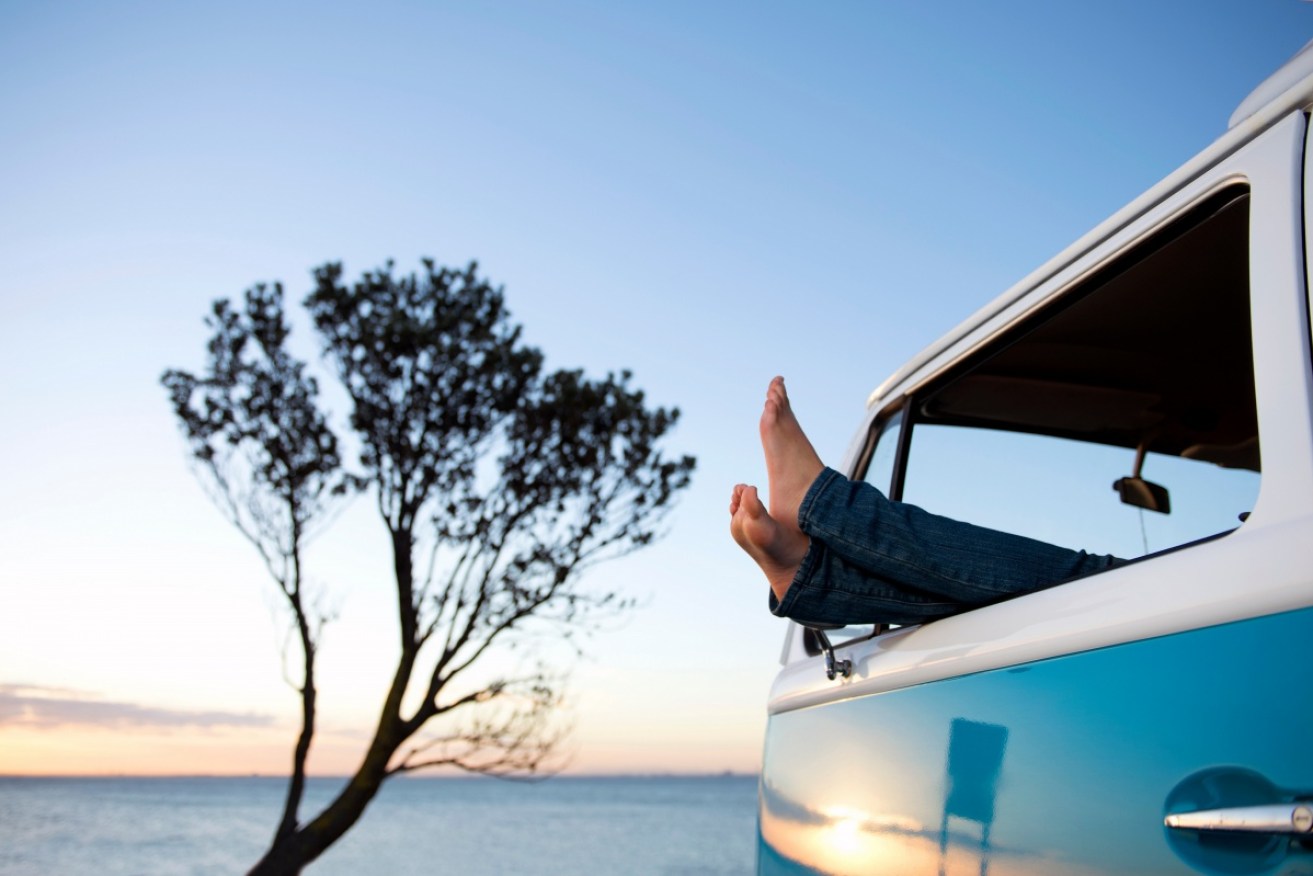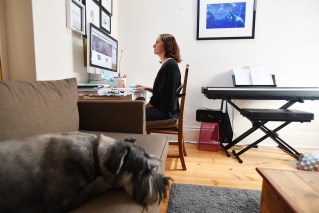Rise of the Australian ‘rurapolitan’


It’s late – nine or ten at night – and you’re driving a highway lit only by the moon. The car is warm, but outside it’s all of five degrees.
On the stereo you’ve got Bruce Springsteen’s Nebraska for company, a haunting melody.
Wisps of fog drift in and out of the headlights like ghosts. The pale light of an occasional farmhouse is the only sign of human life.
And then there it is. Your turning. The gravel drive. The bark of dogs. Soon you’re inside, the log fire bursting into life, a good drop of whiskey in hand. Home at last.
It’s a drive I’ve taken many times in the past few years, and the thrill is not wearing off.
From the bustle of Southern Cross station in Melbourne, to the park-and-ride station at a mid-size country town, and on to a little farmhouse in the middle of nowhere can take two or three hours.
But when the fire crackles and rain drums lightly on the tin roof, it’s worth every minute.
These kinds of experiences are the stuff of dreams for what we’ve grown used to calling ‘tree-changers’.
A shack on a hill, clean air, the friendly local pub, fresh eggs and herbs from the neighbour’s yard, long chats at the village shop, dam-caught fish washed down with local wine, acres for the dogs to run over, beautiful sunrises, parrots and eagles above, and magpies chatting to each other along the back fence.
It’s not a new dream, but in recent times there seem to be plenty of articles telling you why it’s out of reach: ‘When the tree-change dream turns to dust’, or ‘The truth about a tree change‘ or ‘Tree change: Is the idyllic lifestyle all it’s cracked up to be? ‘
Well, perhaps they’re right. Many starry-eyed tree-changers from the 1970s, ’80s and ’90s ended up back in the big cities, much to the delight of those who never had the nerve to go.
And yet times change. Over the five years I’ve been splitting my time between country and city, I’ve begun to realise that ‘tree-change’ is not the right term at all.
A number of recent developments make it easier than ever to love both rural and metropolitan life, just on different days.
A better word to describe these new developments first appeared in geography books half a century ago: ‘rurapolitan’.
Rurapolitans redefined
In the late 1950s, ‘rurapolitan’ was occasionally used by public servants or geographers to describe an observable social trend – namely the growing urge to work in the city, but commute in from enclaves of prestige in the countryside.
That came with some snobby, class- and race-based baggage. Here, for instance, is American Healthier living author JJ Schifferes writing in 1959:

The 1950s family of ‘rurapolitians’ was white, rich, privileged. Photo: Getty
“The new ‘rurapolitan’ civilisation is now the dominating influence on American markets, culture and politics. It already houses the bulk of the white American population …
“With city-employed families withdrawn to Rurapolia, the big cities are rapidly becoming the home of the minorities, of the childless, and of the misfit. Rurapolia is here to stay, and it incorporates many of the sturdy old rural virtues, as well as the sophistications of the city.”
So let’s dump that definition right there.
The developments I want to look at below were beyond imagining back in 1959, and they are making the choice of living in both city and country something that is accessible to a broad socio-economic spectrum.
It’s also worth noting that there was a brief flurry of discussion of ‘ruralpolitans’ (that’s with an ‘L’ in the middle) in the US during the 2008/09 financial crisis.
They were, according to the real estate agents who used the term, disaffected city slickers who saw rural land as pretty much the last safe investment.
And hell, even if it wasn’t, at least it’d be somewhere to build a shack when the global economy finally collapsed.
That’s where the term came from, but I want to move away from both these definitions, because for five years I’ve been observing, and participating, in a rurapolitan trend that is different to both.
In my experience the new rurapolitans are not people fleeing the city. Rather they are people blurring of boundaries between city and country – and that very much includes established country folk blurring the lines the other way.
They’re making the ‘city’ more a state of mind than a geographical location.
House-price push
Perhaps the greatest force driving this change is Australia’s house price boom. I came to the rurapolitan lifestyle by a twist of fate, but it was very much linked to that 20-year boom.
During the all-too-common experience of a ‘divorce asset split’ I had to decide whether to buy out the family home in the city, or alternatively start renting and take over the modest rental property we’d bought out in the sticks.

It’s not much, but then neither is the mortgage. Photo: Getty
When I crunched the numbers, the choice became obvious. I could buy the old farmhouse, rent a decent home in the city, and still be several hundred dollars better off each month.
How is that possible? Simply because in the past 20 years, the cost of buying a capital city home has decoupled from the cost of renting.
Big-city house prices have more than doubled in inflation-adjusted terms since the year 2000, while rents have grown much more slowly.
According to housing research firm CoreLogic, city house prices have grown 1.4 times more than rents across Australia in the past decade.
If you live in bubble-city Melbourne, that figure’s an astonishing 2.4 times.
Rental growth, which hit 8 per cent per annum just before the financial crisis, has been declining ever since. Average rental growth across Australia’s capitals turned negative in early 2016, and rents are expected to fall further due to a looming apartment supply glut.
So depending on where you live, the idea of owning a country home and renting a pied-à-terre in the city is no longer just for the wealthy. In areas where the house prices and rents have diverged the most, it’s likely to be cheaper.
Two warnings
There are two caveats that should be attached to all this.
Firstly, Australians have become a bit obsessed about the on-paper value of their homes. Owning a rural home, where prices have not bubbled higher in recent years, is generally not a way to ‘build wealth’, as your financial planner might put it.

Super-commuting is fine, but not too often. Photo: Getty
On the other hand, a city home has to be sold or remortgaged to get hold of all that money.
If you plan to do that in retirement, you’ll no doubt be able to buy your dream rural retreat later in life.
However, for those like myself with a real hankering for country life, the flip-side is 20 more years paying off a mortgage in the city.
The rurapolitan choice, as I see it, is about getting on with a different lifestyle now – not waiting for your assets to mature.
The second caveat is to do with kids. If you plan to have them, there are plenty of good schools in regional communities, and plenty of country kids moving to the big smoke to pursue apprenticeships or tertiary education.
But going down that road is more the full ‘tree-change’ experience than a rurapolitian life, so would-be parents have to make a clear choice one way or the other.
For those who don’t wish to have kids, of course, that choice doesn’t arise.
Likewise for parents whose kids are getting into young adulthood. They’re often happier to see less of mum and dad, and with millennials leaving home later than in previous generations, they are likely to be happy looking after the city rental while Mum and Dad are chasing alpacas round the paddock.
And let’s not forget people like yours truly. My rental home is close to my kids’ schools, and I’m there with them a couple of nights a week. Every second weekend – the other part of a modern divorced parent’s 50-50 custody – they revel in coming to the bush.
Work to live
Those caveats aside, there is another economic aspect to Rurapolia: smaller overheads mean you may not have to work as many days per week.
The nature of work is changing across the developed world, with the ‘knowledge economy’ playing an ever larger role.

Modern logistics and online shopping means the world delivers to your front verandah. Photo: Getty
Journalism and other forms of writing and editing fit that category, but so do many careers previously tied to a geographical location – education, accounting, the growing field of e-health, law, design, photography, engineering, software coding and so on.
The point is not that workers in those fields never have to visit a city office, or city-based client, but that with a little organisation the ‘city’ part of those careers can be part-time.
To quote another 1950s writer, the sociologist LF Schnore, “the daily journey to work may be tending to supersede migration as a means of adjustment to change … the maximum distance from centres of activity at which a worker tends to locate is fixed at that point beyond which further savings in rent are insufficient to cover the added costs of transportation”.
Well he wasn’t wrong back then, but when the worker only needs to commute a couple of times a week, that distance increases.
The ‘super-commuter’ who makes that run daily will soon burn out. But those who do it once or twice a week will be fine – and there’s much more than Nebraska to listen to on those drives home.
Getting more from the city
Remember too that lower overheads at home mean more money to spend in town.
A friend, who runs a shop in a nearby town, told me recently she sees a lot more theatre and live music in Melbourne since she moved out. She books the tickets and a hotel at the same time to make a night of it, and still ends the month miles in front financially.

Lower overheads can mean working fewer days to cover them. Photo: Getty
Realistically, a round trip by car and train could cost $50 or more, so rurapolitans with no home in the city may prefer a night in a hotel to save time and commuting costs.
The point is to get what you need, and want, from the city without having to be there all the time.
All told, then, there are a few economic angles to the lifestyle that those 1950s sociologists couldn’t have foreseen.
But what about those other ‘new’ developments? Here are some that I’ve observed.
The transport revolution
Even a decade ago, you might look at the long-range commuter and ask “how many thousands of dollars are you spending on petrol?” Good question.
But the question is starting to lose relevance due to the rapidly expanding market for hybrid or pure-electric vehicles.

BMW’s all-electric i3 … expensive to buy, cheap to run.
In the case of hybrids, mileage figures are exceptionally low. And all-electric vehicles such as BMW’s i3 are now rated to cover 245km on battery alone, or up to 370km with the petrol range-extender option.
These cars have a very high ‘sticker shock’ price, but manufacturers point out the low ‘cost of ownership’.
Electricity to run them is a fraction of the cost of petrol, and there’s very little to service on electric vehicles.
Finally, and not quite here yet, is the driverless car revolution.
I spend long drives listening to talk radio, audio-books, or music. However if the computer was driving I could work or read all the way to town.
The renewables revolution
Large-scale renewable energy in Australia, more so than in nations such as Germany, France, China and the UK, is being held back by concerted lobbying from fossil fuel interests.
One result of that is that frustrated individuals, or groups of businesses setting up mini-grids, are just getting on with it themselves.
That can create big challenges in the city, where the roof space for solar, or the open space for wind power often don’t exist.
Out in Rurapolia, however, there’s plenty of space for all.
The cost of a decent-sized solar installation, with a lithium-based home storage solution, has fallen dramatically in the past couple of years.
Furthermore, those who stay connected to the grid can benefit from selling off surplus power in summer, and topping up batteries with off-peak power when the sun’s not shining.
For example, Energy Matters is currently promoting a 5.2kW system it says will “reduce your grid energy use up to 80 per cent”, paid for at $95 per week over five years.
That’s $24,700 for a system that’s guaranteed for 10 years against hardware faults, and for 25 years for the hardware performing at the rated energy levels.
Put that together with an electric vehicle, and energy and transport costs for living out of town will soon be a fraction of what they once were.
The logistics revolution
I find I’m often dining with neighbours and friends, and occasionally I bravely cook something myself. But what if the recipe depends on those little red chillies I forget to buy yesterday?
My nearest supermarket is a 40-minute round trip, and to be sure of getting those chillies I’d probably have to do an hour’s round trip.

Transport and energy costs will come down for the self-sufficient. Photo: Getty
However, being just off a major highway, I can place an online order with Woolworths (probably Coles too, but I haven’t tried it yet) and get the goodies delivered later that day.
The efficiency of modern logistics can be quite astonishing.
And that’s before you consider the ease of buying all kinds of niche goods online that to earlier generations would have required a lot more shopping around by phone, and possibly a long drive to get them within a decent timeframe.
In recent months a new post-hole digger (three days), watch (a week), and, ahem, new whiskey glasses (two days) have all lobbed up on my front verandah or down at the local post office.
What were cities for again?
The social media revolution
It pretty much goes without saying that the ‘telecommuter’ imagined back in the 1980s and 1990s is finally getting some work done.
The point of the information and communication technology (ICT) revolution turned out not to be the ‘possibility’ of collaborating with colleagues via video conferencing and online workflow systems, but the rock-solid reliability of such systems.

Facebook is a big thing in country areas, but so is face-to-face socialising. Photo: Getty
From my desk an hour-and-a-half outside Melbourne, I have to say that is only just now reaching that level. Five years ago it was a disaster.
That said, one of my neighbours has abandoned the water-logged copper line to the Telstra exchange. Bush internet, they tell me, is a whole new experience since they connected to an NBN satellite service.
The other aspect of ICT is that social media is always there. No matter how far your roam, your extended social network can be in your pocket.
As with my friend’s theatre trips, a small amount of planning means you can plan as many or as few social engagements as you like before you arrive in the city.
As it happens, I’ve started doing that less. One of the greatest parts of living in the country is the good-hearted and surprisingly varied mix of people I’ve got to know. Most of them use Facebook, but there’s a hell of a lot of what I call ‘face-to-face-book’.
There’s the knock at the door for a cuppa, a glass of wine to watch the sun go down together, and evening beer at the local pub, the drive-in movie screen occasionally set up in a paddock, the country races, car shows, local markets, and just about any other excuse to get together. Social life is as busy as you can handle.
Country living isn’t for everyone, and not for every stage of life.
But for those who love it, the new developments listed above are like an extended version of the boiling frog experiment.
Gradually, all of the means of escape have become available.
All it takes is the decision to hop out.








